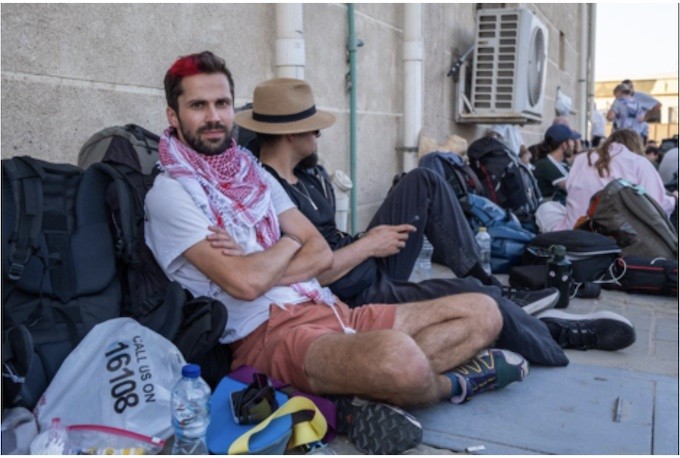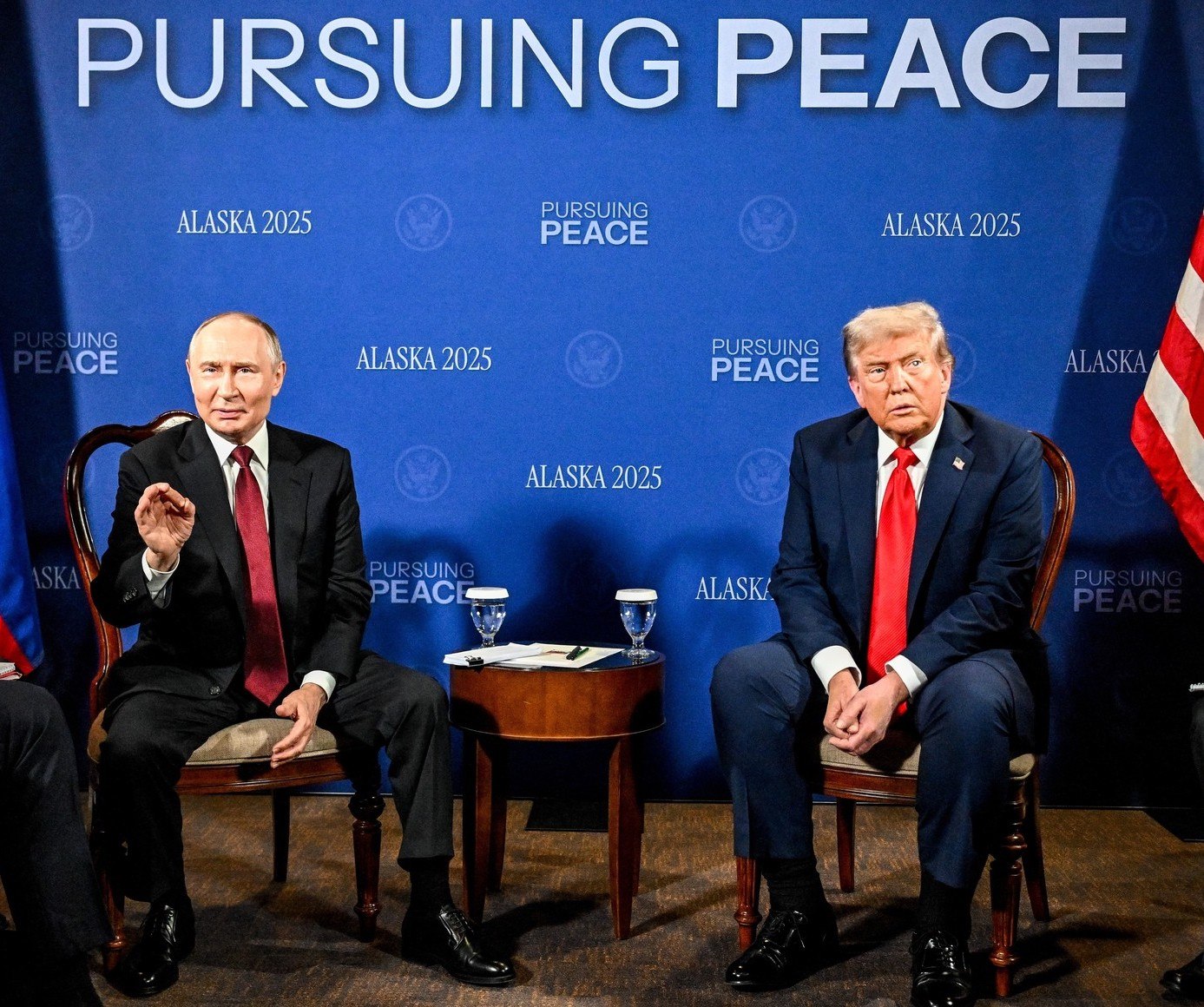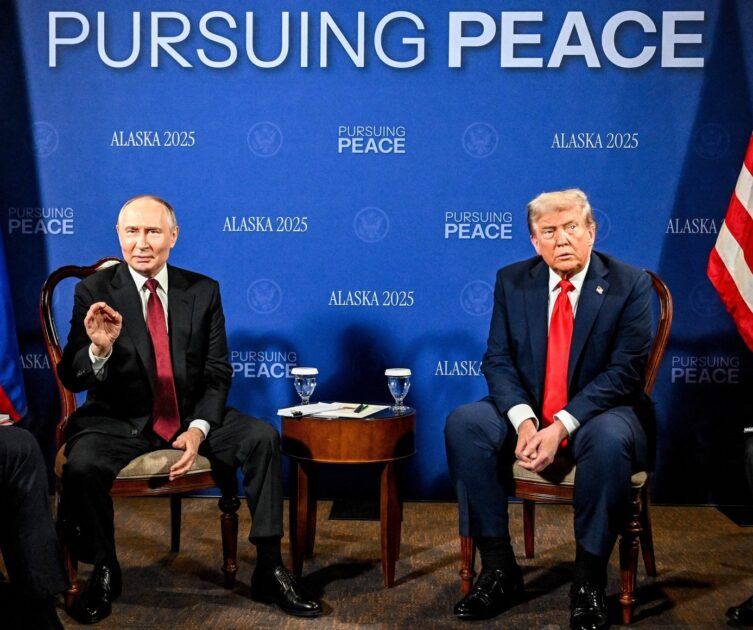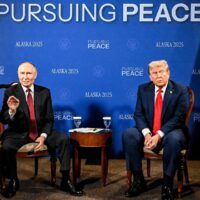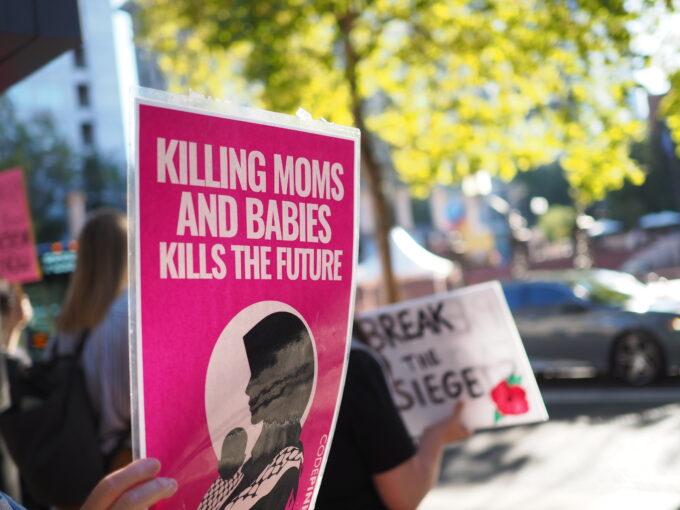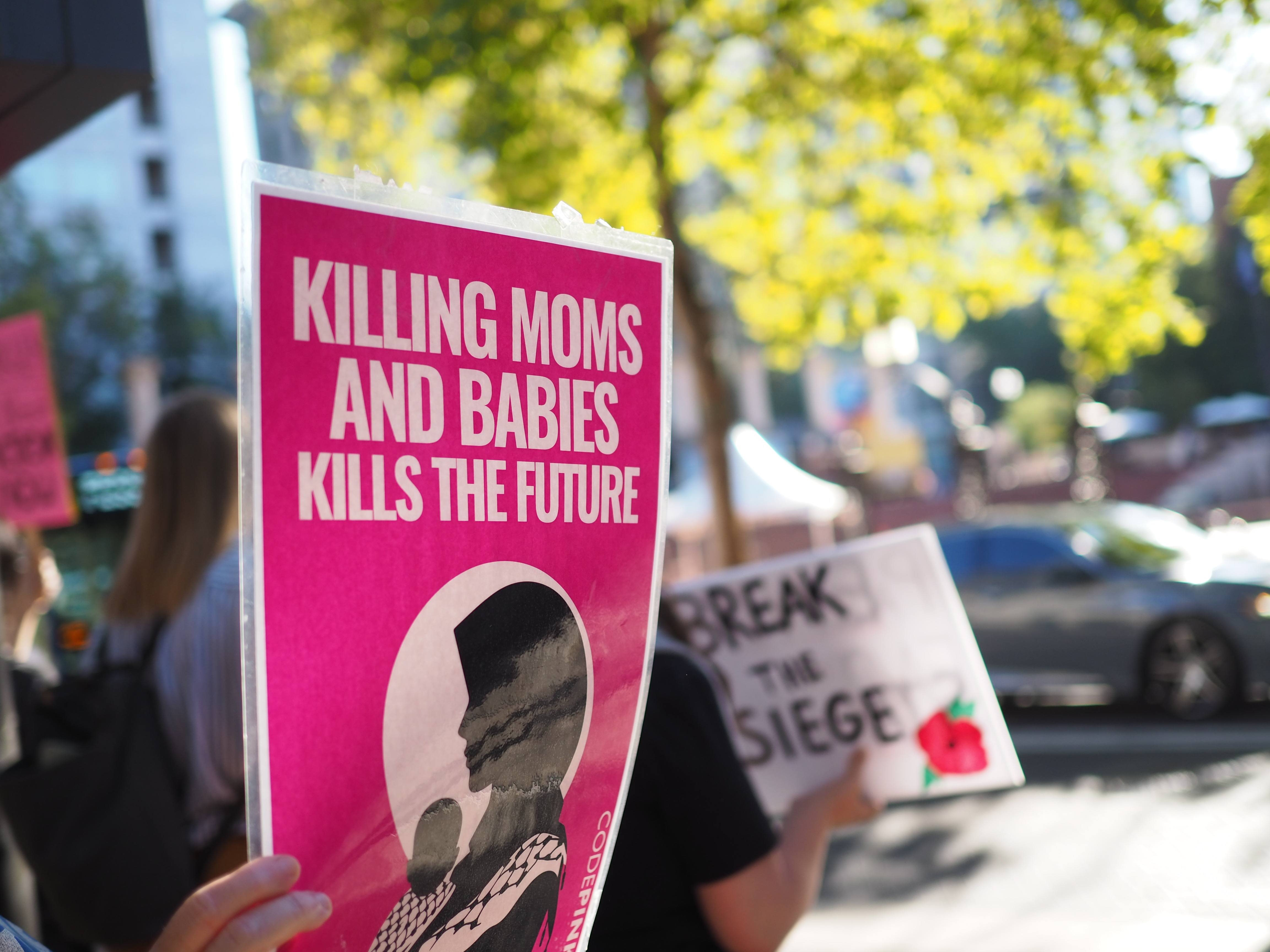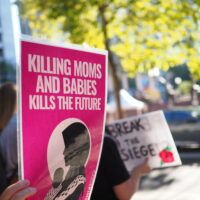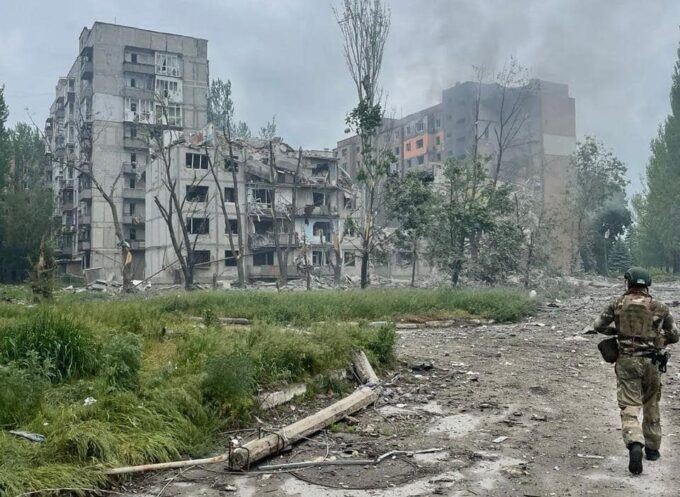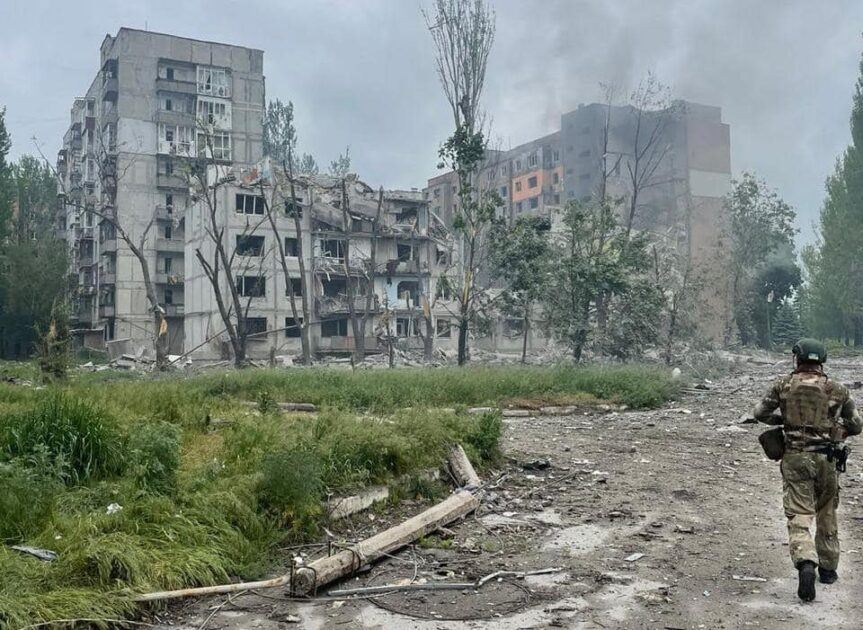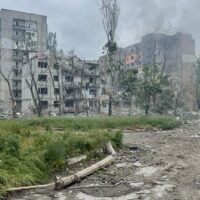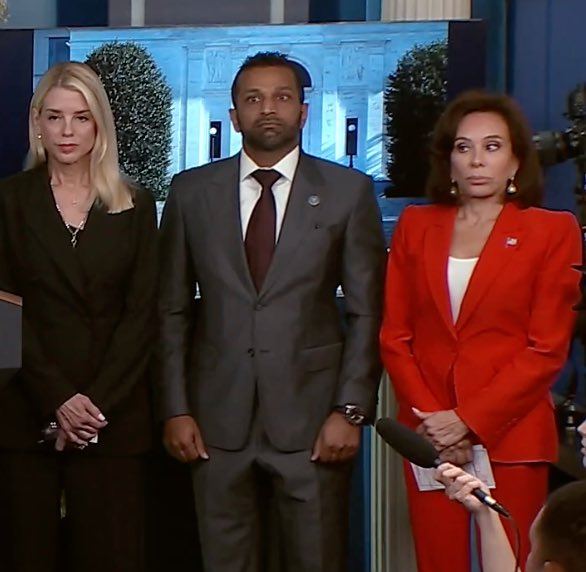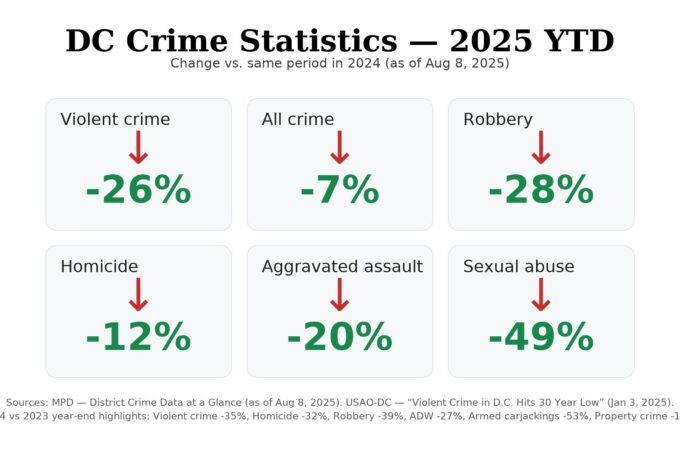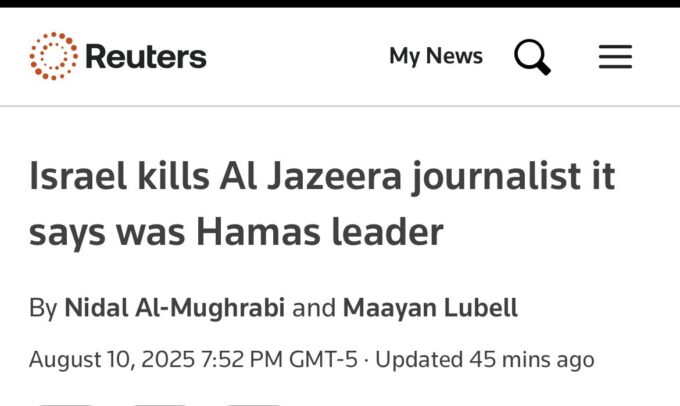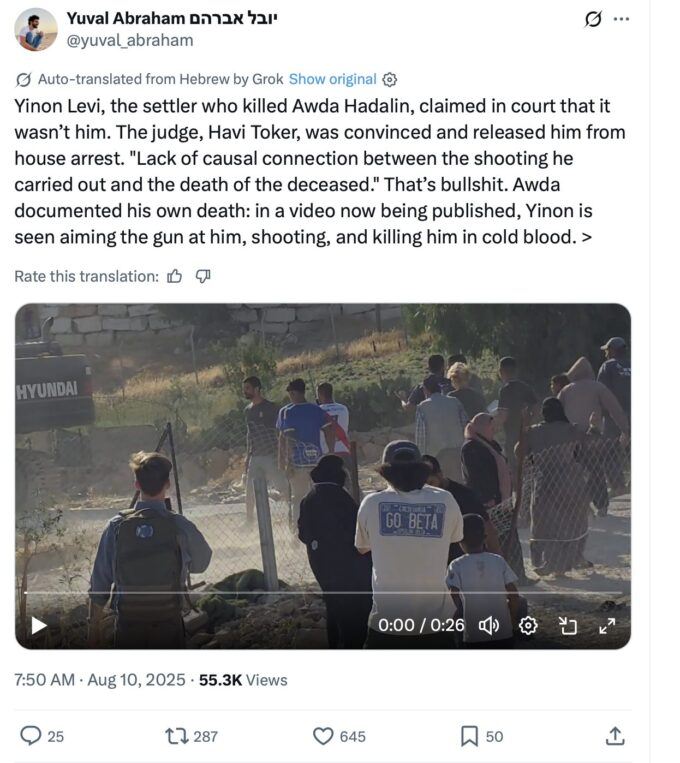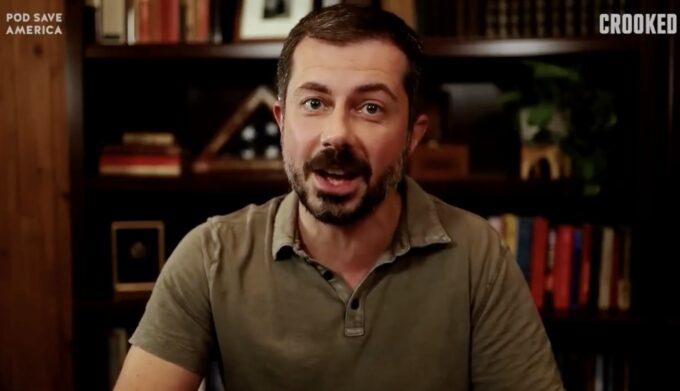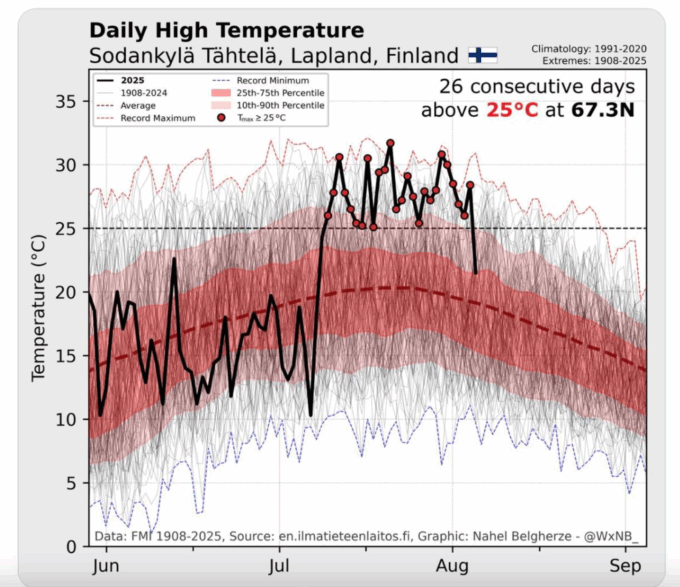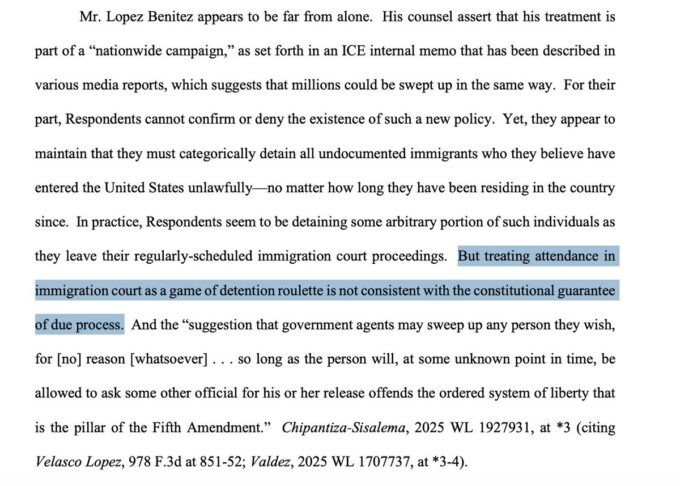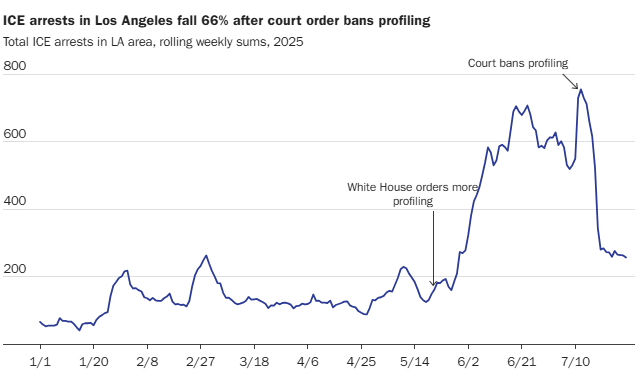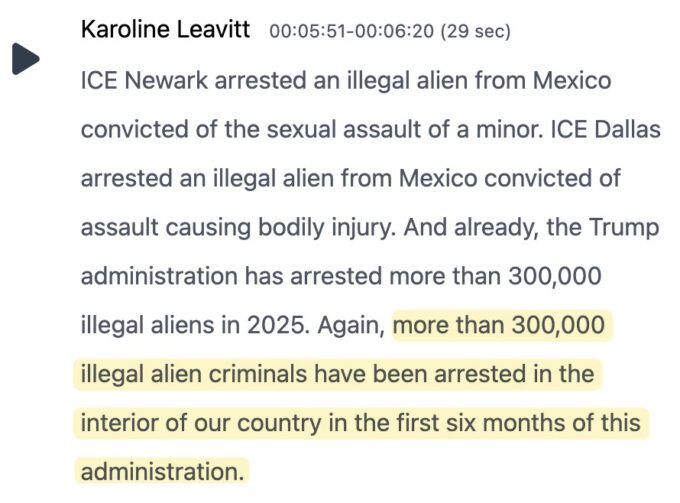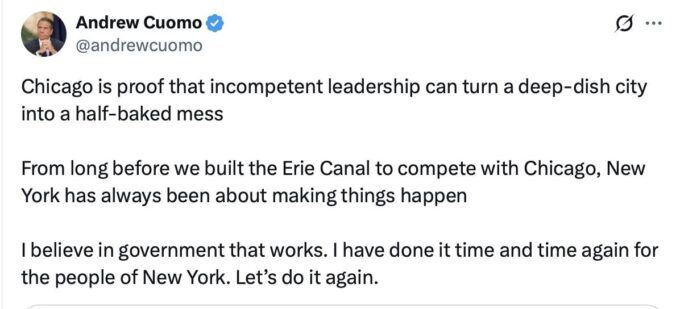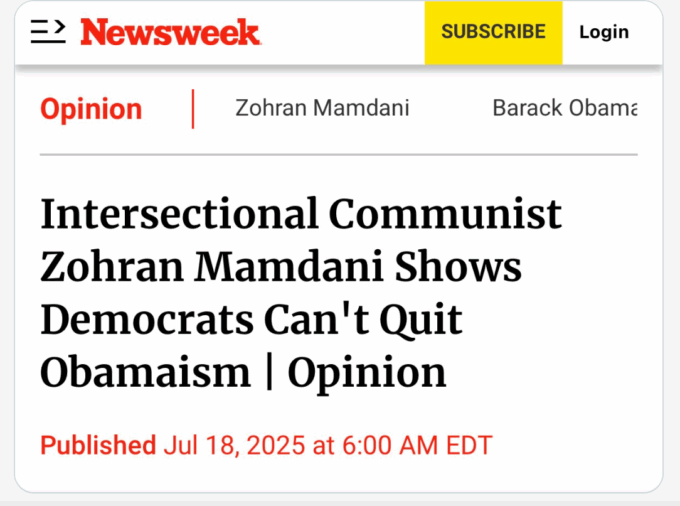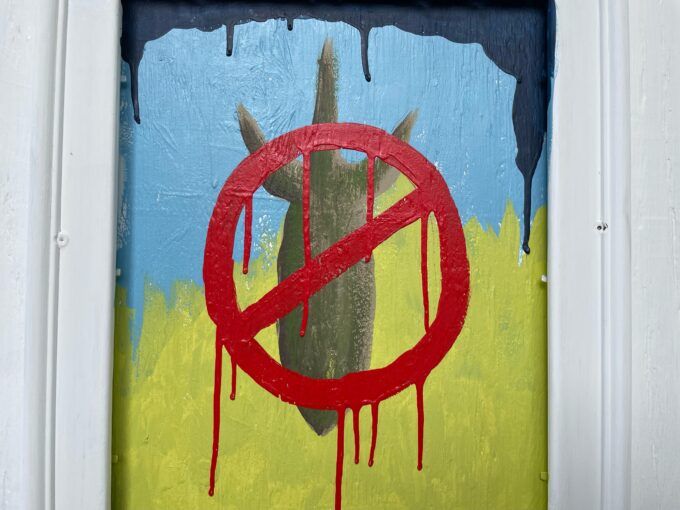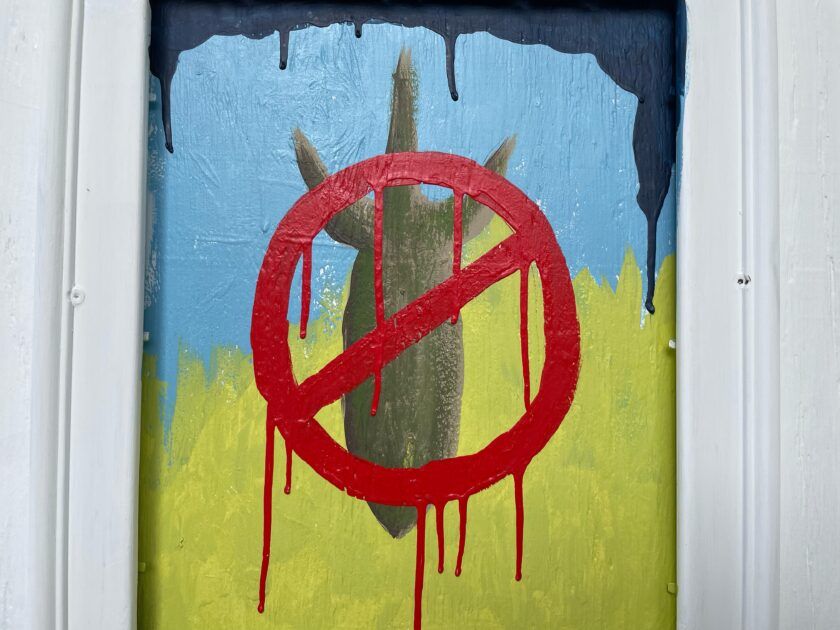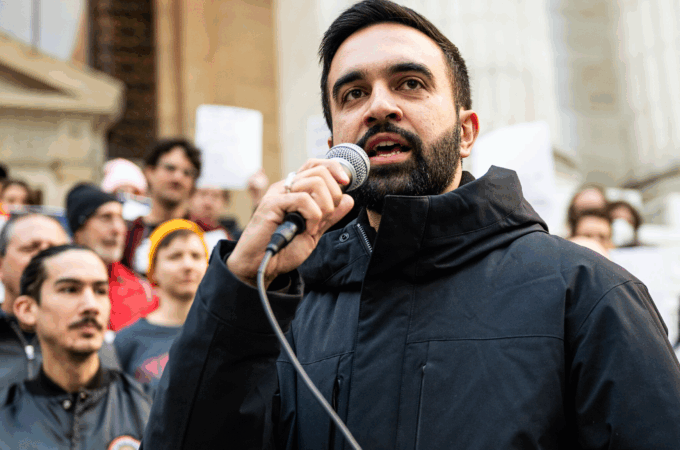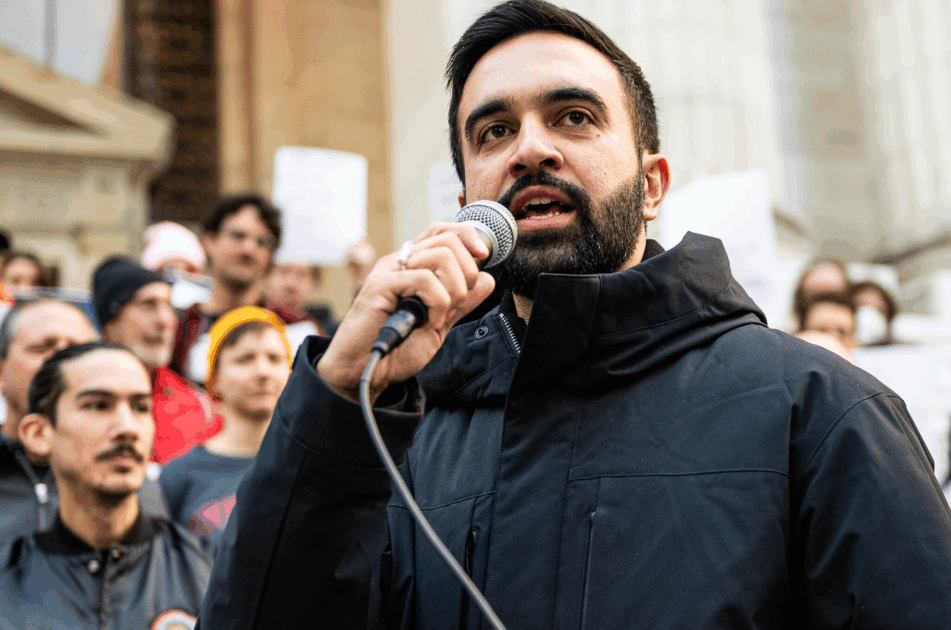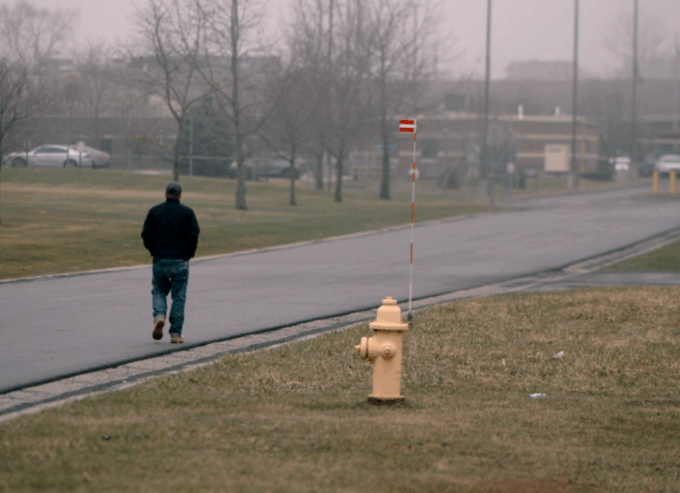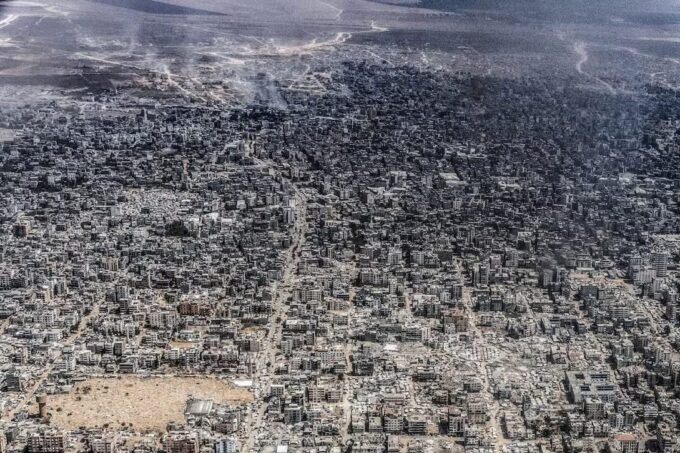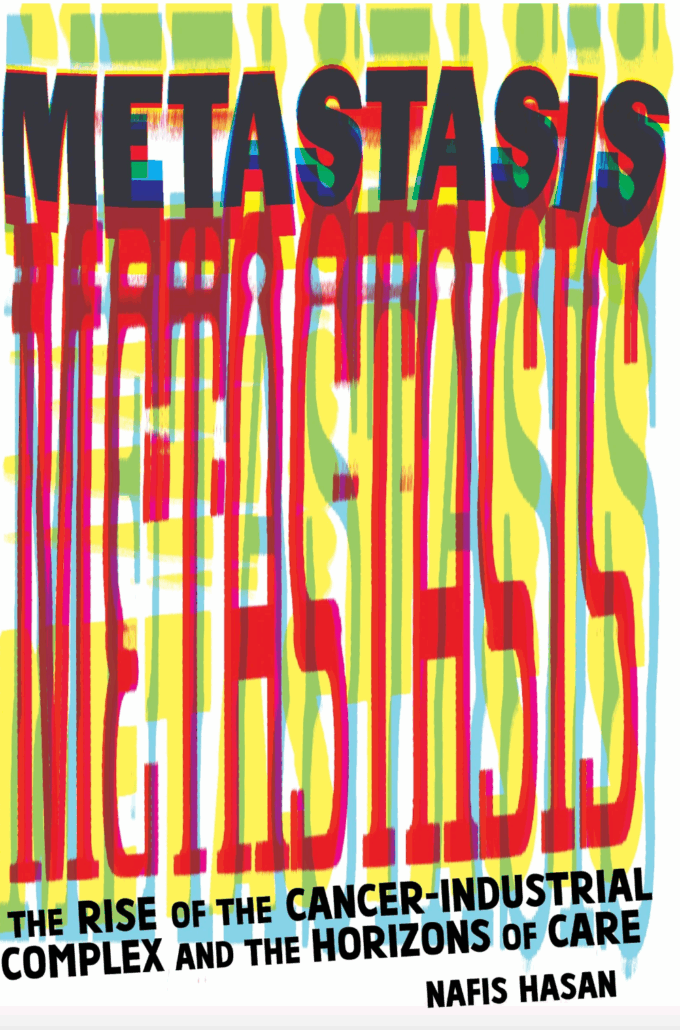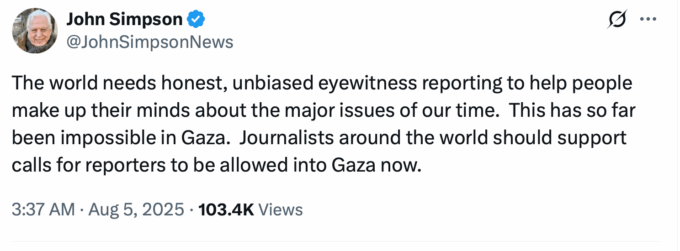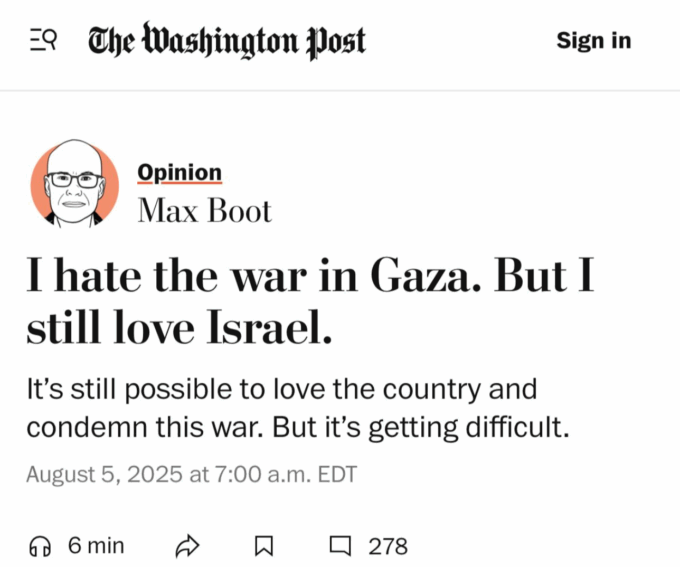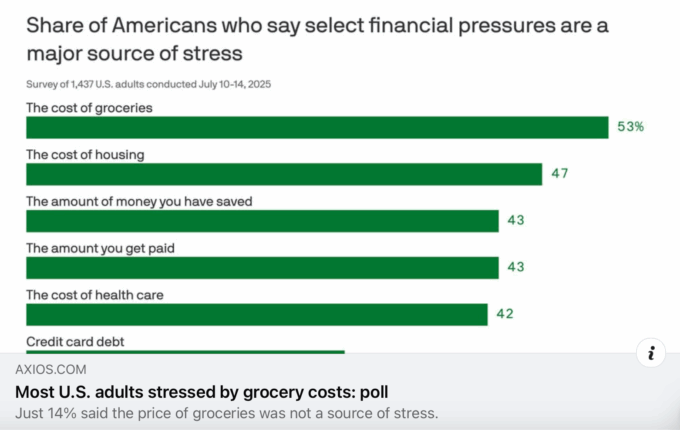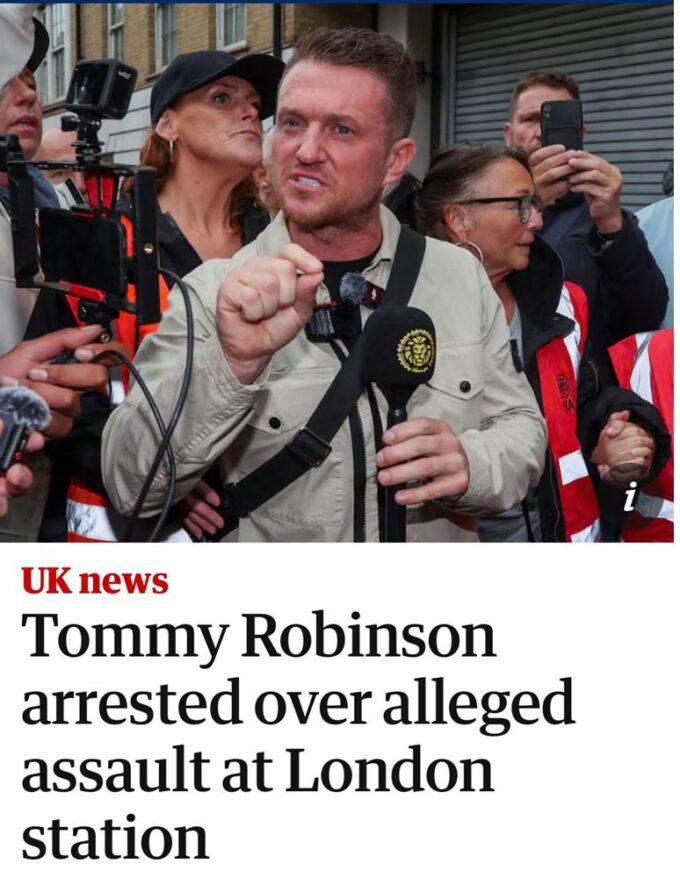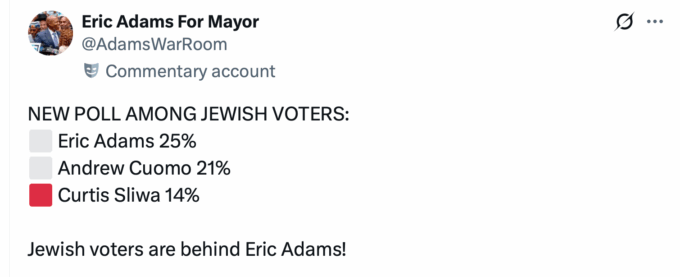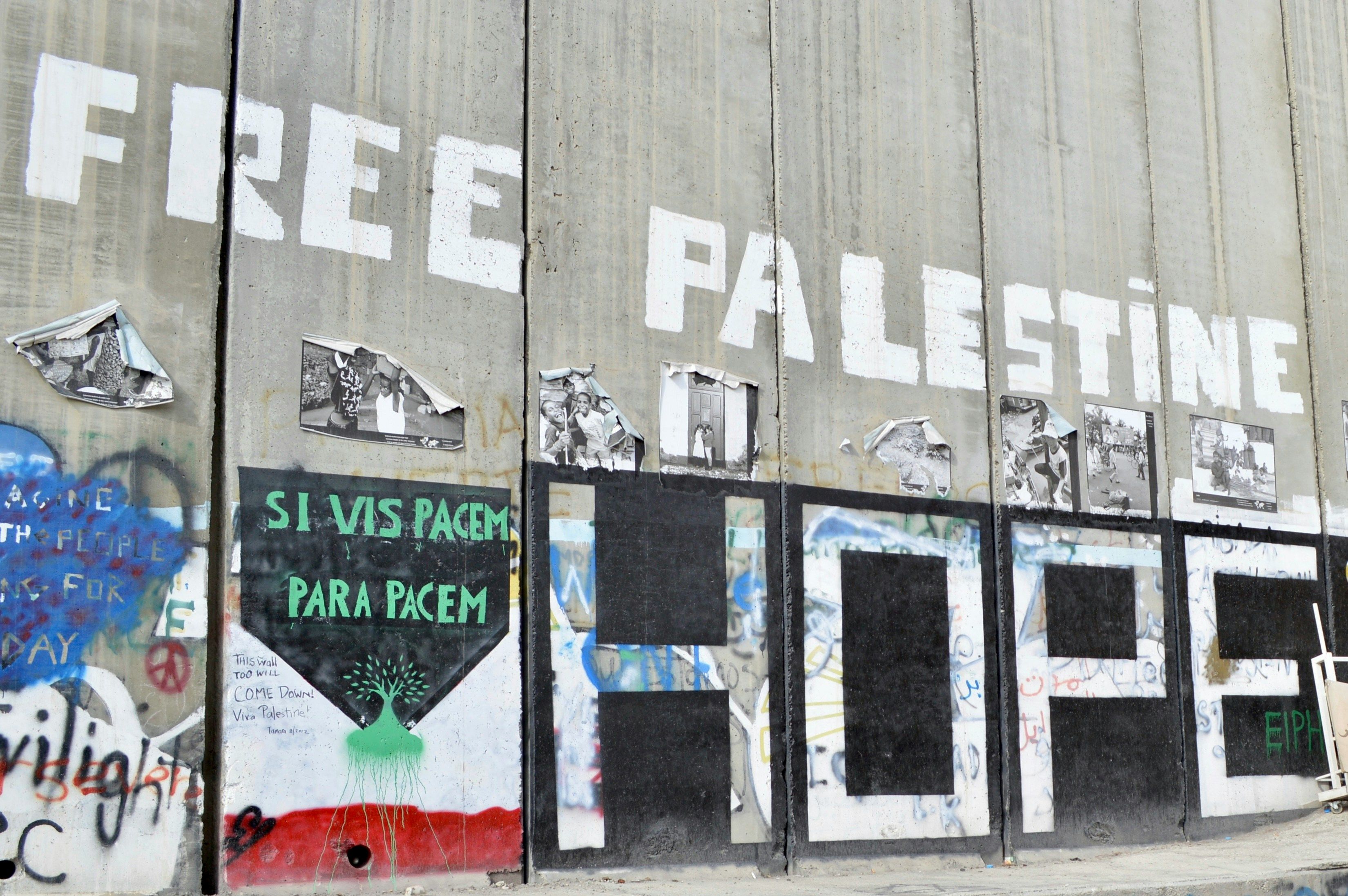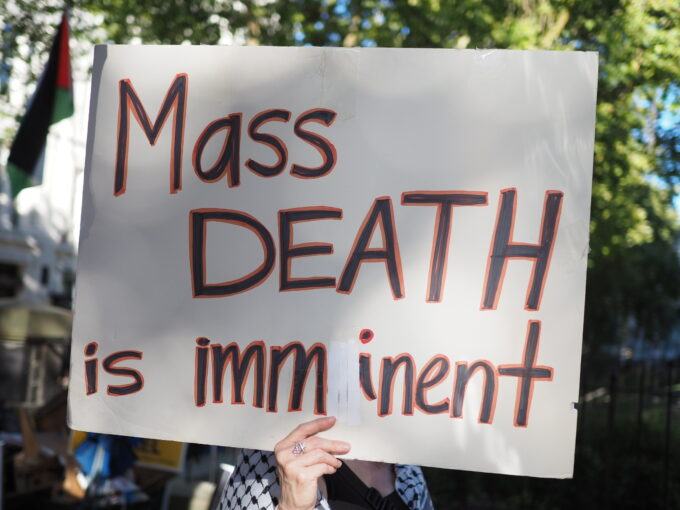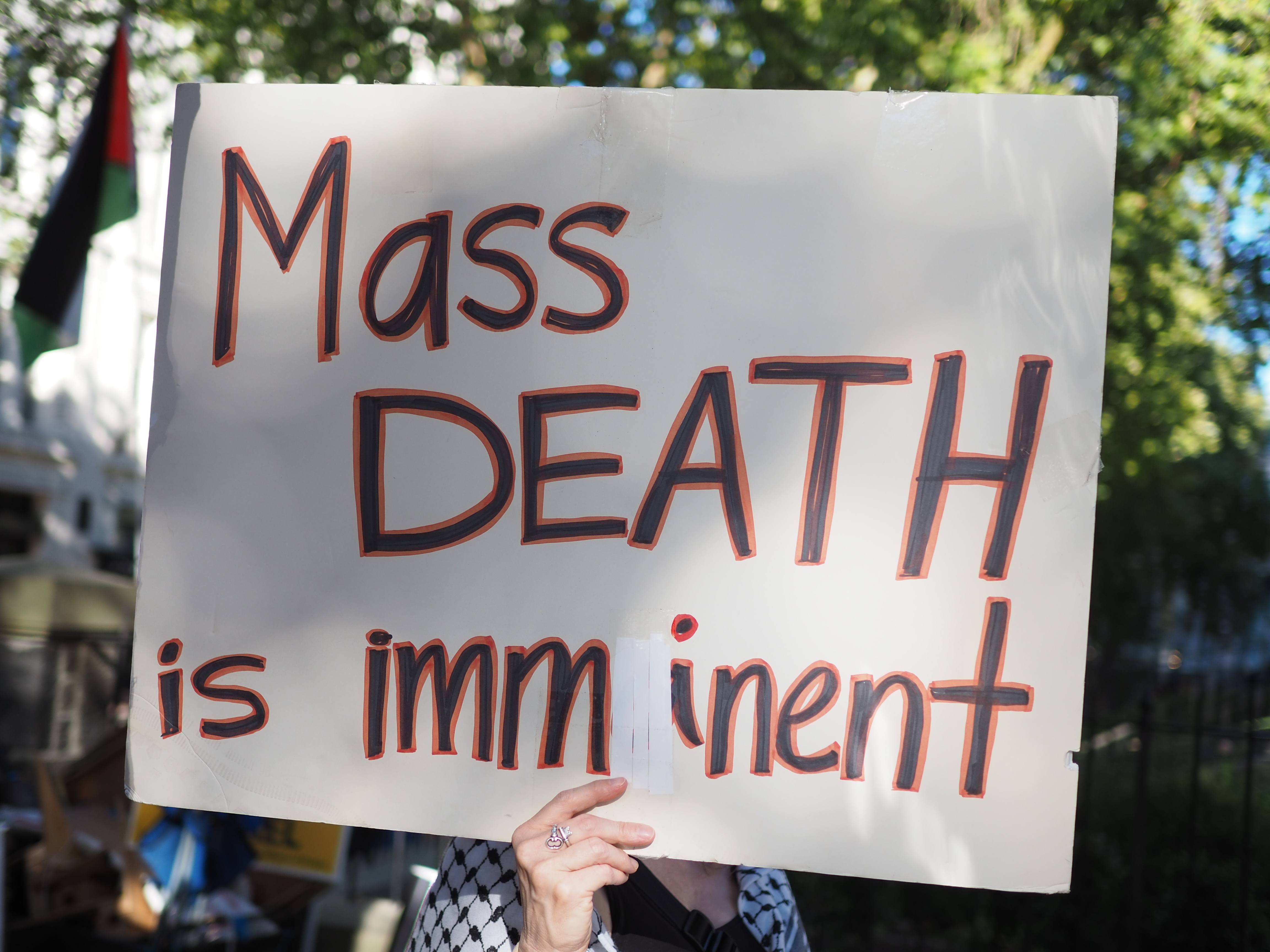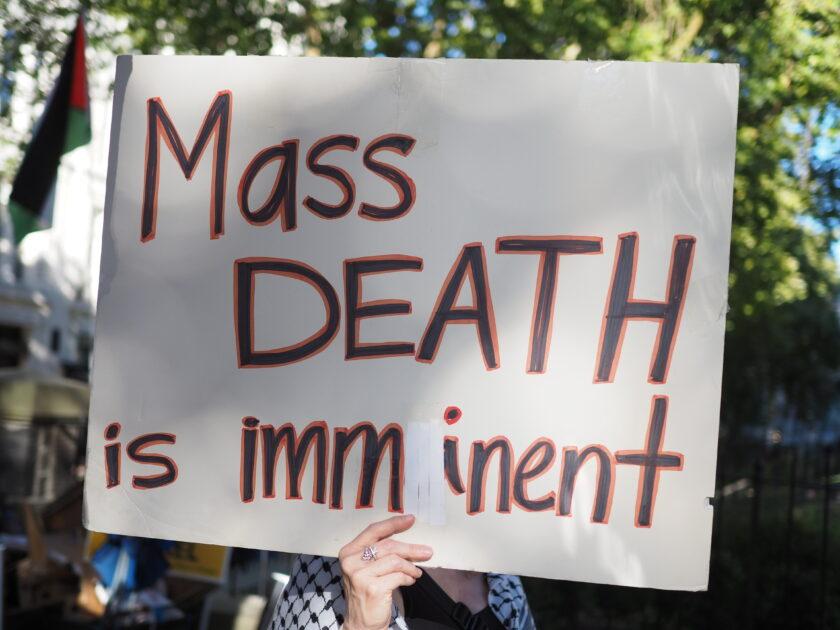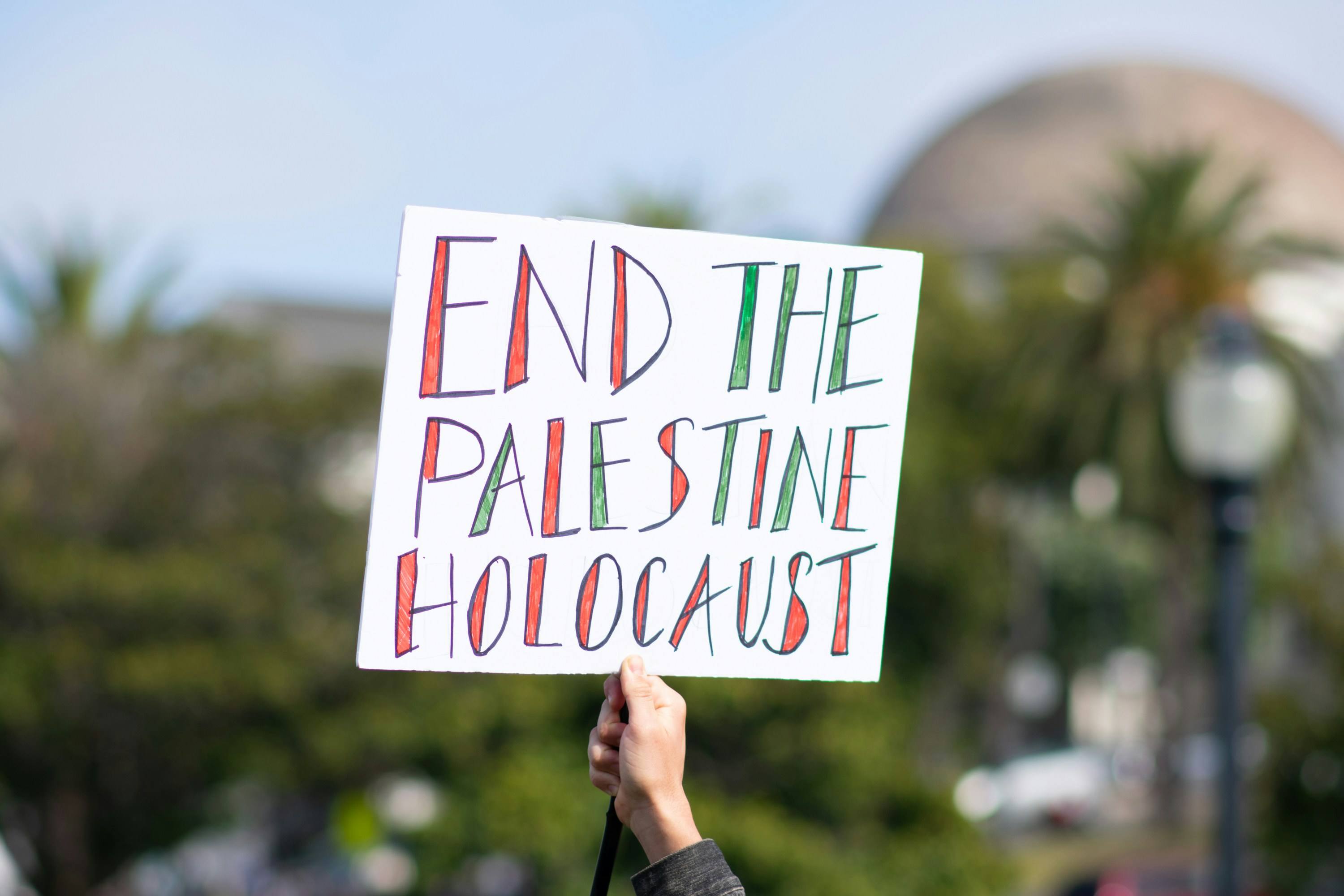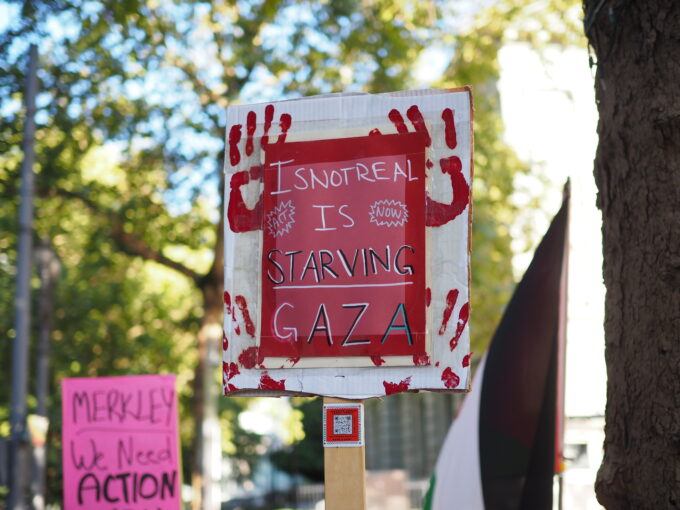








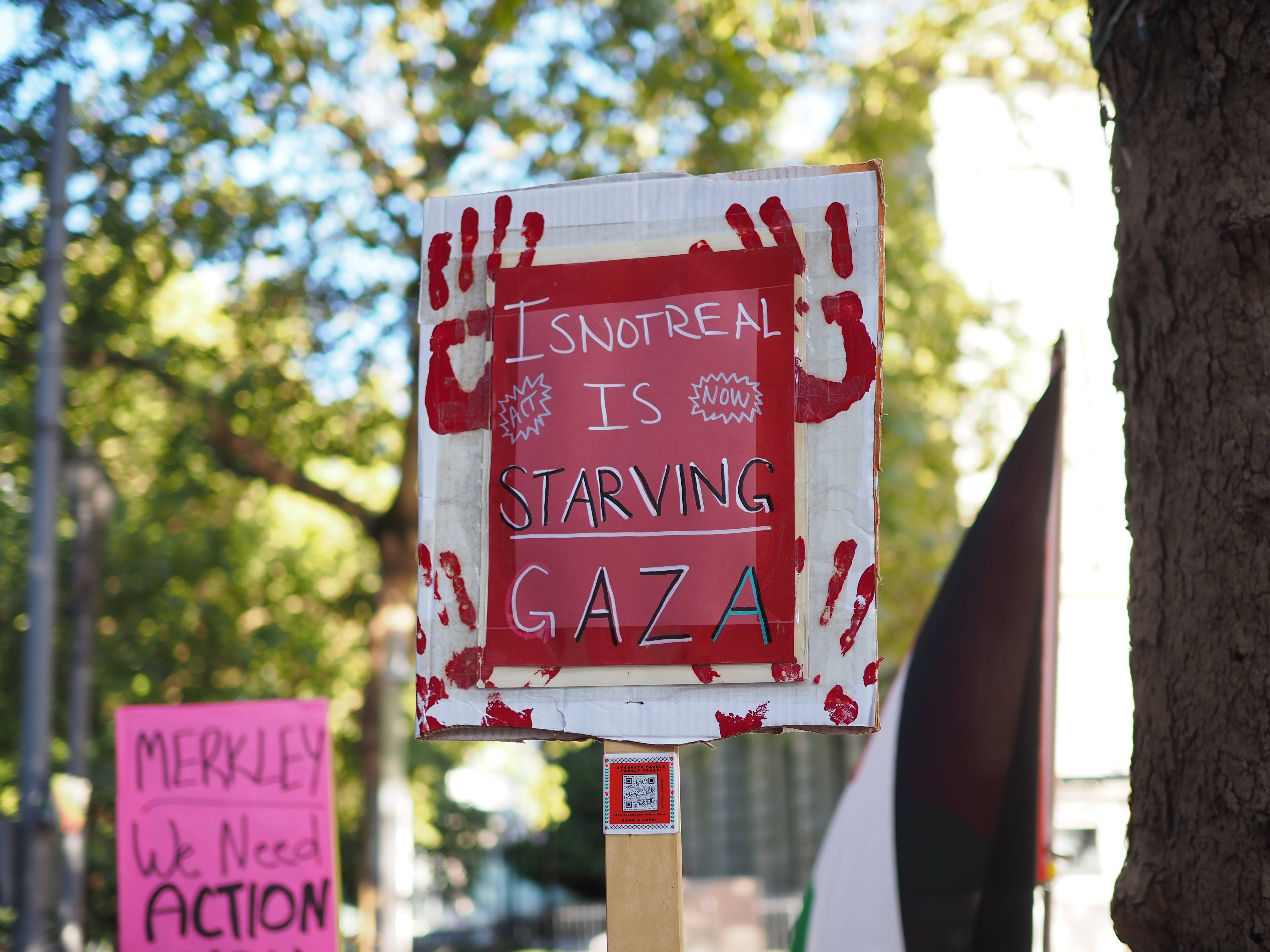

























































Photograph by Nathaniel St. Clair
“Flush with newfound confidence and authority, Mr. Netanyahu seemed finally to have gained the political capital he needed to override opposition from his far-right government allies to reach a truce in Gaza.”
– The New York Times, August 5, 2025, p. 1, “With Fate in His Hands, Netanyahu Fumbles It.”
The New York Times, over the years has been an apologist for Israel and Israel policies no matter how blameworthy, and the page one story cited above is typical of its biased reporting. The author (Patrick Kingsley) assumes that Netanyahu actually wants a cease fire; that the right-wing coalition is responsible for blocking it; and that Netanyahu gained the “political capital” in Iran that he was seeking in order to get a truce. All of these assumptions can be challenged.
It’s only been in the last few months that the Times has acknowledged the horrors of Israeli bombardments of Gaza and the fact that the International Criminal Court has issued an arrest warrant for Prime Minister Benjamin Netanyahu. But as recently as last week, the Times’ lead story emphatically stated that Netanyahu is not to blame for the failure to reach a cease-fire in Gaza—that the right-wing opposition is responsible.
Until recently, the mainstream media fully supported the Israeli view that Hamas is responsible for the protracted nature of the war in Gaza. Palestinian suffering was given short shrift until journalists got into Gaza and witnessed the devastation first hand instead of relying on propagandistic Israeli press accounts.
“Flush with newfound confidence and authority, Mr. Netanyahu seemed finally to have gained the political capital he needed to override opposition from his far-right government allies to reach a truce in Gaza.” (The New York Times, August 5, 2025, p. 1, “With Fate in His Hands, Netanyahu Fumbles It.”}
The New York Times over the years has been an apologist for Israel and Israel policies no matter how blameworthy, and the page one story cited above is typical of its biased reporting. The author (Patrick Kingsley) assumes that Netanyahu actually wants a cease fire; that the right-wing coalition is responsible for blocking it; and that Netanyahu gained the “political capital” in Iran that he was seeking in order to get a truce. All of these assumptions can be challenged.
It’s only been in the last few months that the Times has acknowledged the horrors of Israeli bombardments of Gaza and the fact that the International Criminal Court has issued an arrest warrant for Prime Minister Benjamin Netanyahu. But as recently as last week, the Times’ lead story emphatically stated that Netanyahu is not to blame for the failure to reach a cease-fire in Gaza—that the right-wing opposition is responsible.
Until recently, the mainstream media fully supported the Israeli view that Hamas is responsible for the protracted nature of the war in Gaza. Palestinian suffering was given short shrift until journalists got into Gaza and witnessed the devastation first hand instead of relying on propagandistic Israeli press accounts.
Several days after Kingsley’s article, the Times reported that Netanyahu was preparing to tell his security cabinet that Israel is planning to take military control over the entire 26-mile Gaza Strip, ignoring the advice of Israeli military leaders. Donald Trump stated that an Israeli takeover of Gaza was “really up to Israel.” Like the military, Mossad intelligence officials also warned that expanding operations in Gaza could endanger the hostages and kill more Palestinian civilians. The Israeli military has reported that most of the Hamas leadership has been decimated; the Hamas arsenal has been destroyed; and that additional bombardment will threaten the 20 remaining hostages still alive.
Prominent Israeli military officials have informed the government that the war has been won and that there is no purpose in continuing the bombardment. However, not a single high-ranking military or intelligence official has criticized, let alone refused participation, in the Israeli genocidal campaign that has involved mass killings of Palestinian civilians.
When a cease-fire was finally declared in January 2025, it was Netanyahu who broke it in March. Once again, the mainstream media argued that Netanyahu had to do so to keep his right-wing coalition together, but it is becoming increasingly likely that Netanyahu chose to do so in order to avoid the additional judicial proceedings that he faces. In August, he achieved one of his major domestic objectives when the Knesset voted unanimously to dismiss Attorney General Gali Baharav-Miara, one of his most prominent critics. The Israeli High Court must now rule on the legality of the Knesset vote.
Netanyahu faces serious legal and political challenges if he decides to support a cease-fire in Gaza; the far-right members of his coalition could bring down the government and force an election. An election loss for Netanyahu would make him vulnerable to corruption charges that have pursued him for the past five years. Another recent development in the mainstream media is their acknowledgment that Netanyahu is prolonging the war so that he doesn’t face another general election until October 2026.
As a result, the war drags on with mounting deaths of Palestinian civilians, including thousands of children under the age of 11, as well as Israeli hostages who are dying in captivity. Netanyahu has been branded a “war criminal,” and Israel has become a pariah state. The International Court of Justice is considering claims that Israel is committing genocide, and several Israeli human rights organizations as well as prominent Israeli intellectuals have already reached that conclusion. Saudi Arabia had been moving in the direction of an exchange of diplomatic relations with Israel, but the mounting civilian deaths, particularly the gruesome deaths of children from malnutrition, have ended any chance for recognition in the near term.
Public opinion in Europe and the United States is certainly moving into an anti-Israeli orbit. French President Emmanuel Macron is preparing to recognize a Palestinian state at the UN meeting in September; several European states have already done so. The Democratic Party, which heretofore backed Israeli policy, is now becoming seriously divided over the issue of Israel’s use of excessive military force. These differences may have contributed to Kamala Harris’s election loss in 2024. The collateral damage of Israel’s war is mounting, and the pain and suffering for the hostages, their families, and the Palestinians will worsen.“Flush with newfound confidence and authority, Mr. Netanyahu seemed finally to have gained the political capital he needed to override opposition from his far-right government allies to reach a truce in Gaza.” (The New York Times, August 5, 2025, p. 1, “With Fate in His Hands, Netanyahu Fumbles It.”}
The New York Times over the years has been an apologist for Israel and Israel policies no matter how blameworthy, and the page one story cited above is typical of its biased reporting. The author (Patrick Kingsley) assumes that Netanyahu actually wants a cease fire; that the right-wing coalition is responsible for blocking it; and that Netanyahu gained the “political capital” in Iran that he was seeking in order to get a truce. All of these assumptions can be challenged.
It’s only been in the last few months that the Times has acknowledged the horrors of Israeli bombardments of Gaza and the fact that the International Criminal Court has issued an arrest warrant for Prime Minister Benjamin Netanyahu. But as recently as last week, the Times’ lead story emphatically stated that Netanyahu is not to blame for the failure to reach a cease-fire in Gaza—that the right-wing opposition is responsible.
Until recently, the mainstream media fully supported the Israeli view that Hamas is responsible for the protracted nature of the war in Gaza. Palestinian suffering was given short shrift until journalists got into Gaza and witnessed the devastation first hand instead of relying on propagandistic Israeli press accounts.
Several days after Kingsley’s article, the Times reported that Netanyahu was preparing to tell his security cabinet that Israel is planning to take military control over the entire 26-mile Gaza Strip, ignoring the advice of Israeli military leaders. Donald Trump stated that an Israeli takeover of Gaza was “really up to Israel.” Like the military, Mossad intelligence officials also warned that expanding operations in Gaza could endanger the hostages and kill more Palestinian civilians. The Israeli military has reported that most of the Hamas leadership has been decimated; the Hamas arsenal has been destroyed; and that additional bombardment will threaten the 20 remaining hostages still alive.
Prominent Israeli military officials have informed the government that the war has been won and that there is no purpose in continuing the bombardment. However, not a single high-ranking military or intelligence official has criticized, let alone refused participation, in the Israeli genocidal campaign that has involved mass killings of Palestinian civilians.
When a cease-fire was finally declared in January 2025, it was Netanyahu who broke it in March. Once again, the mainstream media argued that Netanyahu had to do so to keep his right-wing coalition together, but it is becoming increasingly likely that Netanyahu chose to do so in order to avoid the additional judicial proceedings that he faces. In August, he achieved one of his major domestic objectives when the Knesset voted unanimously to dismiss Attorney General Gali Baharav-Miara, one of his most prominent critics. The Israeli High Court must now rule on the legality of the Knesset vote.
Netanyahu faces serious legal and political challenges if he decides to support a cease-fire in Gaza; the far-right members of his coalition could bring down the government and force an election. An election loss for Netanyahu would make him vulnerable to corruption charges that have pursued him for the past five years. Another recent development in the mainstream media is their acknowledgment that Netanyahu is prolonging the war so that he doesn’t face another general election until October 2026.
As a result, the war drags on with mounting deaths of Palestinian civilians, including thousands of children under the age of 11, as well as Israeli hostages who are dying in captivity. Netanyahu has been branded a “war criminal,” and Israel has become a pariah state. The International Court of Justice is considering claims that Israel is committing genocide, and several Israeli human rights organizations as well as prominent Israeli intellectuals have already reached that conclusion. Saudi Arabia had been moving in the direction of an exchange of diplomatic relations with Israel, but the mounting civilian deaths, particularly the gruesome deaths of children from malnutrition, have ended any chance for recognition in the near term.
Public opinion in Europe and the United States is certainly moving into an anti-Israeli orbit. French President Emmanuel Macron is preparing to recognize a Palestinian state at the UN meeting in September; several European states have already done so. The Democratic Party, which heretofore backed Israeli policy, is now becoming seriously divided over the issue of Israel’s use of excessive military force. These differences may have contributed to Kamala Harris’s election loss in 2024. The collateral damage of Israel’s war is mounting, and the pain and suffering for the hostages, their families, and the Palestinians will worsen.“Flush with newfound confidence and authority, Mr. Netanyahu seemed finally to have gained the political capital he needed to override opposition from his far-right government allies to reach a truce in Gaza.” (The New York Times, August 5, 2025, p. 1, “With Fate in His Hands, Netanyahu Fumbles It.”}
The New York Times over the years has been an apologist for Israel and Israel policies no matter how blameworthy, and the page one story cited above is typical of its biased reporting. The author (Patrick Kingsley) assumes that Netanyahu actually wants a cease fire; that the right-wing coalition is responsible for blocking it; and that Netanyahu gained the “political capital” in Iran that he was seeking in order to get a truce. All of these assumptions can be challenged.
It’s only been in the last few months that the Times has acknowledged the horrors of Israeli bombardments of Gaza and the fact that the International Criminal Court has issued an arrest warrant for Prime Minister Benjamin Netanyahu. But as recently as last week, the Times’ lead story emphatically stated that Netanyahu is not to blame for the failure to reach a cease-fire in Gaza—that the right-wing opposition is responsible.
Until recently, the mainstream media fully supported the Israeli view that Hamas is responsible for the protracted nature of the war in Gaza. Palestinian suffering was given short shrift until journalists got into Gaza and witnessed the devastation first hand instead of relying on propagandistic Israeli press accounts.
Several days after Kingsley’s article, the Times reported that Netanyahu was preparing to tell his security cabinet that Israel is planning to take military control over the entire 26-mile Gaza Strip, ignoring the advice of Israeli military leaders. Donald Trump stated that an Israeli takeover of Gaza was “really up to Israel.” Like the military, Mossad intelligence officials also warned that expanding operations in Gaza could endanger the hostages and kill more Palestinian civilians. The Israeli military has reported that most of the Hamas leadership has been decimated; the Hamas arsenal has been destroyed; and that additional bombardment will threaten the 20 remaining hostages still alive.
Prominent Israeli military officials have informed the government that the war has been won and that there is no purpose in continuing the bombardment. However, not a single high-ranking military or intelligence official has criticized, let alone refused participation, in the Israeli genocidal campaign that has involved mass killings of Palestinian civilians.
When a cease-fire was finally declared in January 2025, it was Netanyahu who broke it in March. Once again, the mainstream media argued that Netanyahu had to do so to keep his right-wing coalition together, but it is becoming increasingly likely that Netanyahu chose to do so in order to avoid the additional judicial proceedings that he faces. In August, he achieved one of his major domestic objectives when the Knesset voted unanimously to dismiss Attorney General Gali Baharav-Miara, one of his most prominent critics. The Israeli High Court must now rule on the legality of the Knesset vote.
Netanyahu faces serious legal and political challenges if he decides to support a cease-fire in Gaza; the far-right members of his coalition could bring down the government and force an election. An election loss for Netanyahu would make him vulnerable to corruption charges that have pursued him for the past five years. Another recent development in the mainstream media is their acknowledgment that Netanyahu is prolonging the war so that he doesn’t face another general election until October 2026.
As a result, the war drags on with mounting deaths of Palestinian civilians, including thousands of children under the age of 11, as well as Israeli hostages who are dying in captivity. Netanyahu has been branded a “war criminal,” and Israel has become a pariah state. The International Court of Justice is considering claims that Israel is committing genocide, and several Israeli human rights organizations as well as prominent Israeli intellectuals have already reached that conclusion. Saudi Arabia had been moving in the direction of an exchange of diplomatic relations with Israel, but the mounting civilian deaths, particularly the gruesome deaths of children from malnutrition, have ended any chance for recognition in the near term.
Public opinion in Europe and the United States is certainly moving into an anti-Israeli orbit. French President Emmanuel Macron is preparing to recognize a Palestinian state at the UN meeting in September; several European states have already done so. The Democratic Party, which heretofore backed Israeli policy, is now becoming seriously divided over the issue of Israel’s use of excessive military force. These differences may have contributed to Kamala Harris’s election loss in 2024. The collateral damage of Israel’s war is mounting, and the pain and suffering for the hostages, their families, and the Palestinians will worsen.“Flush with newfound confidence and authority, Mr. Netanyahu seemed finally to have gained the political capital he needed to override opposition from his far-right government allies to reach a truce in Gaza.” (The New York Times, August 5, 2025, p. 1, “With Fate in His Hands, Netanyahu Fumbles It.”}
The New York Times over the years has been an apologist for Israel and Israel policies no matter how blameworthy, and the page one story cited above is typical of its biased reporting. The author (Patrick Kingsley) assumes that Netanyahu actually wants a cease fire; that the right-wing coalition is responsible for blocking it; and that Netanyahu gained the “political capital” in Iran that he was seeking in order to get a truce. All of these assumptions can be challenged.
It’s only been in the last few months that the Times has acknowledged the horrors of Israeli bombardments of Gaza and the fact that the International Criminal Court has issued an arrest warrant for Prime Minister Benjamin Netanyahu. But as recently as last week, the Times’ lead story emphatically stated that Netanyahu is not to blame for the failure to reach a cease-fire in Gaza—that the right-wing opposition is responsible.
Until recently, the mainstream media fully supported the Israeli view that Hamas is responsible for the protracted nature of the war in Gaza. Palestinian suffering was given short shrift until journalists got into Gaza and witnessed the devastation first hand instead of relying on propagandistic Israeli press accounts.
Several days after Kingsley’s article, the Times reported that Netanyahu was preparing to tell his security cabinet that Israel is planning to take military control over the entire 26-mile Gaza Strip, ignoring the advice of Israeli military leaders. Donald Trump stated that an Israeli takeover of Gaza was “really up to Israel.” Like the military, Mossad intelligence officials also warned that expanding operations in Gaza could endanger the hostages and kill more Palestinian civilians. The Israeli military has reported that most of the Hamas leadership has been decimated; the Hamas arsenal has been destroyed; and that additional bombardment will threaten the 20 remaining hostages still alive.
Prominent Israeli military officials have informed the government that the war has been won and that there is no purpose in continuing the bombardment. However, not a single high-ranking military or intelligence official has criticized, let alone refused participation, in the Israeli genocidal campaign that has involved mass killings of Palestinian civilians.
When a cease-fire was finally declared in January 2025, it was Netanyahu who broke it in March. Once again, the mainstream media argued that Netanyahu had to do so to keep his right-wing coalition together, but it is becoming increasingly likely that Netanyahu chose to do so in order to avoid the additional judicial proceedings that he faces. In August, he achieved one of his major domestic objectives when the Knesset voted unanimously to dismiss Attorney General Gali Baharav-Miara, one of his most prominent critics. The Israeli High Court must now rule on the legality of the Knesset vote.
Netanyahu faces serious legal and political challenges if he decides to support a cease-fire in Gaza; the far-right members of his coalition could bring down the government and force an election. An election loss for Netanyahu would make him vulnerable to corruption charges that have pursued him for the past five years. Another recent development in the mainstream media is their acknowledgment that Netanyahu is prolonging the war so that he doesn’t face another general election until October 2026.
As a result, the war drags on with mounting deaths of Palestinian civilians, including thousands of children under the age of 11, as well as Israeli hostages who are dying in captivity. Netanyahu has been branded a “war criminal,” and Israel has become a pariah state. The International Court of Justice is considering claims that Israel is committing genocide, and several Israeli human rights organizations as well as prominent Israeli intellectuals have already reached that conclusion. Saudi Arabia had been moving in the direction of an exchange of diplomatic relations with Israel, but the mounting civilian deaths, particularly the gruesome deaths of children from malnutrition, have ended any chance for recognition in the near term.
Public opinion in Europe and the United States is certainly moving into an anti-Israeli orbit. French President Emmanuel Macron is preparing to recognize a Palestinian state at the UN meeting in September; several European states have already done so. The Democratic Party, which heretofore backed Israeli policy, is now becoming seriously divided over the issue of Israel’s use of excessive military force. These differences may have contributed to Kamala Harris’s election loss in 2024. The collateral damage of Israel’s war is mounting, and the pain and suffering for the hostages, their families, and the Palestinians will worsen.“Flush with newfound confidence and authority, Mr. Netanyahu seemed finally to have gained the political capital he needed to override opposition from his far-right government allies to reach a truce in Gaza.” (The New York Times, August 5, 2025, p. 1, “With Fate in His Hands, Netanyahu Fumbles It.”}
The New York Times over the years has been an apologist for Israel and Israel policies no matter how blameworthy, and the page one story cited above is typical of its biased reporting. The author (Patrick Kingsley) assumes that Netanyahu actually wants a cease fire; that the right-wing coalition is responsible for blocking it; and that Netanyahu gained the “political capital” in Iran that he was seeking in order to get a truce. All of these assumptions can be challenged.
It’s only been in the last few months that the Times has acknowledged the horrors of Israeli bombardments of Gaza and the fact that the International Criminal Court has issued an arrest warrant for Prime Minister Benjamin Netanyahu. But as recently as last week, the Times’ lead story emphatically stated that Netanyahu is not to blame for the failure to reach a cease-fire in Gaza—that the right-wing opposition is responsible.
Until recently, the mainstream media fully supported the Israeli view that Hamas is responsible for the protracted nature of the war in Gaza. Palestinian suffering was given short shrift until journalists got into Gaza and witnessed the devastation first hand instead of relying on propagandistic Israeli press accounts.
Several days after Kingsley’s article, the Times reported that Netanyahu was preparing to tell his security cabinet that Israel is planning to take military control over the entire 26-mile Gaza Strip, ignoring the advice of Israeli military leaders. Donald Trump stated that an Israeli takeover of Gaza was “really up to Israel.” Like the military, Mossad intelligence officials also warned that expanding operations in Gaza could endanger the hostages and kill more Palestinian civilians. The Israeli military has reported that most of the Hamas leadership has been decimated; the Hamas arsenal has been destroyed; and that additional bombardment will threaten the 20 remaining hostages still alive.
Prominent Israeli military officials have informed the government that the war has been won and that there is no purpose in continuing the bombardment. However, not a single high-ranking military or intelligence official has criticized, let alone refused participation, in the Israeli genocidal campaign that has involved mass killings of Palestinian civilians.
When a cease-fire was finally declared in January 2025, it was Netanyahu who broke it in March. Once again, the mainstream media argued that Netanyahu had to do so to keep his right-wing coalition together, but it is becoming increasingly likely that Netanyahu chose to do so in order to avoid the additional judicial proceedings that he faces. In August, he achieved one of his major domestic objectives when the Knesset voted unanimously to dismiss Attorney General Gali Baharav-Miara, one of his most prominent critics. The Israeli High Court must now rule on the legality of the Knesset vote.
Netanyahu faces serious legal and political challenges if he decides to support a cease-fire in Gaza; the far-right members of his coalition could bring down the government and force an election. An election loss for Netanyahu would make him vulnerable to corruption charges that have pursued him for the past five years. Another recent development in the mainstream media is their acknowledgment that Netanyahu is prolonging the war so that he doesn’t face another general election until October 2026.
As a result, the war drags on with mounting deaths of Palestinian civilians, including thousands of children under the age of 11, as well as Israeli hostages who are dying in captivity. Netanyahu has been branded a “war criminal,” and Israel has become a pariah state. The International Court of Justice is considering claims that Israel is committing genocide, and several Israeli human rights organizations as well as prominent Israeli intellectuals have already reached that conclusion. Saudi Arabia had been moving in the direction of an exchange of diplomatic relations with Israel, but the mounting civilian deaths, particularly the gruesome deaths of children from malnutrition, have ended any chance for recognition in the near term.
Public opinion in Europe and the United States is certainly moving into an anti-Israeli orbit. French President Emmanuel Macron is preparing to recognize a Palestinian state at the UN meeting in September; several European states have already done so. The Democratic Party, which heretofore backed Israeli policy, is now becoming seriously divided over the issue of Israel’s use of excessive military force. These differences may have contributed to Kamala Harris’s election loss in 2024. The collateral damage of Israel’s war is mounting, and the pain and suffering for the hostages, their families, and the Palestinians will worsen.“Flush with newfound confidence and authority, Mr. Netanyahu seemed finally to have gained the political capital he needed to override opposition from his far-right government allies to reach a truce in Gaza.” (The New York Times, August 5, 2025, p. 1, “With Fate in His Hands, Netanyahu Fumbles It.”}
The New York Times over the years has been an apologist for Israel and Israel policies no matter how blameworthy, and the page one story cited above is typical of its biased reporting. The author (Patrick Kingsley) assumes that Netanyahu actually wants a cease fire; that the right-wing coalition is responsible for blocking it; and that Netanyahu gained the “political capital” in Iran that he was seeking in order to get a truce. All of these assumptions can be challenged.
It’s only been in the last few months that the Times has acknowledged the horrors of Israeli bombardments of Gaza and the fact that the International Criminal Court has issued an arrest warrant for Prime Minister Benjamin Netanyahu. But as recently as last week, the Times’ lead story emphatically stated that Netanyahu is not to blame for the failure to reach a cease-fire in Gaza—that the right-wing opposition is responsible.
Until recently, the mainstream media fully supported the Israeli view that Hamas is responsible for the protracted nature of the war in Gaza. Palestinian suffering was given short shrift until journalists got into Gaza and witnessed the devastation first hand instead of relying on propagandistic Israeli press accounts.
Several days after Kingsley’s article, the Times reported that Netanyahu was preparing to tell his security cabinet that Israel is planning to take military control over the entire 26-mile Gaza Strip, ignoring the advice of Israeli military leaders. Donald Trump stated that an Israeli takeover of Gaza was “really up to Israel.” Like the military, Mossad intelligence officials also warned that expanding operations in Gaza could endanger the hostages and kill more Palestinian civilians. The Israeli military has reported that most of the Hamas leadership has been decimated; the Hamas arsenal has been destroyed; and that additional bombardment will threaten the 20 remaining hostages still alive.
Prominent Israeli military officials have informed the government that the war has been won and that there is no purpose in continuing the bombardment. However, not a single high-ranking military or intelligence official has criticized, let alone refused participation, in the Israeli genocidal campaign that has involved mass killings of Palestinian civilians.
When a cease-fire was finally declared in January 2025, it was Netanyahu who broke it in March. Once again, the mainstream media argued that Netanyahu had to do so to keep his right-wing coalition together, but it is becoming increasingly likely that Netanyahu chose to do so in order to avoid the additional judicial proceedings that he faces. In August, he achieved one of his major domestic objectives when the Knesset voted unanimously to dismiss Attorney General Gali Baharav-Miara, one of his most prominent critics. The Israeli High Court must now rule on the legality of the Knesset vote.
Netanyahu faces serious legal and political challenges if he decides to support a cease-fire in Gaza; the far-right members of his coalition could bring down the government and force an election. An election loss for Netanyahu would make him vulnerable to corruption charges that have pursued him for the past five years. Another recent development in the mainstream media is their acknowledgment that Netanyahu is prolonging the war so that he doesn’t face another general election until October 2026.
As a result, the war drags on with mounting deaths of Palestinian civilians, including thousands of children under the age of 11, as well as Israeli hostages who are dying in captivity. Netanyahu has been branded a “war criminal,” and Israel has become a pariah state. The International Court of Justice is considering claims that Israel is committing genocide, and several Israeli human rights organizations as well as prominent Israeli intellectuals have already reached that conclusion. Saudi Arabia had been moving in the direction of an exchange of diplomatic relations with Israel, but the mounting civilian deaths, particularly the gruesome deaths of children from malnutrition, have ended any chance for recognition in the near term.
Public opinion in Europe and the United States is certainly moving into an anti-Israeli orbit. French President Emmanuel Macron is preparing to recognize a Palestinian state at the UN meeting in September; several European states have already done so. The Democratic Party, which heretofore backed Israeli policy, is now becoming seriously divided over the issue of Israel’s use of excessive military force. These differences may have contributed to Kamala Harris’s election loss in 2024. The collateral damage of Israel’s war is mounting, and the pain and suffering for the hostages, their families, and the Palestinians will worsen.“Flush with newfound confidence and authority, Mr. Netanyahu seemed finally to have gained the political capital he needed to override opposition from his far-right government allies to reach a truce in Gaza.” (The New York Times, August 5, 2025, p. 1, “With Fate in His Hands, Netanyahu Fumbles It.”}
The New York Times over the years has been an apologist for Israel and Israel policies no matter how blameworthy, and the page one story cited above is typical of its biased reporting. The author (Patrick Kingsley) assumes that Netanyahu actually wants a cease fire; that the right-wing coalition is responsible for blocking it; and that Netanyahu gained the “political capital” in Iran that he was seeking in order to get a truce. All of these assumptions can be challenged.
It’s only been in the last few months that the Times has acknowledged the horrors of Israeli bombardments of Gaza and the fact that the International Criminal Court has issued an arrest warrant for Prime Minister Benjamin Netanyahu. But as recently as last week, the Times’ lead story emphatically stated that Netanyahu is not to blame for the failure to reach a cease-fire in Gaza—that the right-wing opposition is responsible.
Until recently, the mainstream media fully supported the Israeli view that Hamas is responsible for the protracted nature of the war in Gaza. Palestinian suffering was given short shrift until journalists got into Gaza and witnessed the devastation first hand instead of relying on propagandistic Israeli press accounts.
Several days after Kingsley’s article, the Times reported that Netanyahu was preparing to tell his security cabinet that Israel is planning to take military control over the entire 26-mile Gaza Strip, ignoring the advice of Israeli military leaders. Donald Trump stated that an Israeli takeover of Gaza was “really up to Israel.” Like the military, Mossad intelligence officials also warned that expanding operations in Gaza could endanger the hostages and kill more Palestinian civilians. The Israeli military has reported that most of the Hamas leadership has been decimated; the Hamas arsenal has been destroyed; and that additional bombardment will threaten the 20 remaining hostages still alive.
Prominent Israeli military officials have informed the government that the war has been won and that there is no purpose in continuing the bombardment. However, not a single high-ranking military or intelligence official has criticized, let alone refused participation, in the Israeli genocidal campaign that has involved mass killings of Palestinian civilians.
When a cease-fire was finally declared in January 2025, it was Netanyahu who broke it in March. Once again, the mainstream media argued that Netanyahu had to do so to keep his right-wing coalition together, but it is becoming increasingly likely that Netanyahu chose to do so in order to avoid the additional judicial proceedings that he faces. In August, he achieved one of his major domestic objectives when the Knesset voted unanimously to dismiss Attorney General Gali Baharav-Miara, one of his most prominent critics. The Israeli High Court must now rule on the legality of the Knesset vote.
Netanyahu faces serious legal and political challenges if he decides to support a cease-fire in Gaza; the far-right members of his coalition could bring down the government and force an election. An election loss for Netanyahu would make him vulnerable to corruption charges that have pursued him for the past five years. Another recent development in the mainstream media is their acknowledgment that Netanyahu is prolonging the war so that he doesn’t face another general election until October 2026.
As a result, the war drags on with mounting deaths of Palestinian civilians, including thousands of children under the age of 11, as well as Israeli hostages who are dying in captivity. Netanyahu has been branded a “war criminal,” and Israel has become a pariah state. The International Court of Justice is considering claims that Israel is committing genocide, and several Israeli human rights organizations as well as prominent Israeli intellectuals have already reached that conclusion. Saudi Arabia had been moving in the direction of an exchange of diplomatic relations with Israel, but the mounting civilian deaths, particularly the gruesome deaths of children from malnutrition, have ended any chance for recognition in the near term.
Public opinion in Europe and the United States is certainly moving into an anti-Israeli orbit. French President Emmanuel Macron is preparing to recognize a Palestinian state at the UN meeting in September; several European states have already done so. The Democratic Party, which heretofore backed Israeli policy, is now becoming seriously divided over the issue of Israel’s use of excessive military force. These differences may have contributed to Kamala Harris’s election loss in 2024. The collateral damage of Israel’s war is mounting, and the pain and suffering for the hostages, their families, and the Palestinians will worsen.“Flush with newfound confidence and authority, Mr. Netanyahu seemed finally to have gained the political capital he needed to override opposition from his far-right government allies to reach a truce in Gaza.” (The New York Times, August 5, 2025, p. 1, “With Fate in His Hands, Netanyahu Fumbles It.”}
The New York Times over the years has been an apologist for Israel and Israel policies no matter how blameworthy, and the page one story cited above is typical of its biased reporting. The author (Patrick Kingsley) assumes that Netanyahu actually wants a cease fire; that the right-wing coalition is responsible for blocking it; and that Netanyahu gained the “political capital” in Iran that he was seeking in order to get a truce. All of these assumptions can be challenged.
It’s only been in the last few months that the Times has acknowledged the horrors of Israeli bombardments of Gaza and the fact that the International Criminal Court has issued an arrest warrant for Prime Minister Benjamin Netanyahu. But as recently as last week, the Times’ lead story emphatically stated that Netanyahu is not to blame for the failure to reach a cease-fire in Gaza—that the right-wing opposition is responsible.
Until recently, the mainstream media fully supported the Israeli view that Hamas is responsible for the protracted nature of the war in Gaza. Palestinian suffering was given short shrift until journalists got into Gaza and witnessed the devastation first hand instead of relying on propagandistic Israeli press accounts.
Several days after Kingsley’s article, the Times reported that Netanyahu was preparing to tell his security cabinet that Israel is planning to take military control over the entire 26-mile Gaza Strip, ignoring the advice of Israeli military leaders. Donald Trump stated that an Israeli takeover of Gaza was “really up to Israel.” Like the military, Mossad intelligence officials also warned that expanding operations in Gaza could endanger the hostages and kill more Palestinian civilians. The Israeli military has reported that most of the Hamas leadership has been decimated; the Hamas arsenal has been destroyed; and that additional bombardment will threaten the 20 remaining hostages still alive.
Prominent Israeli military officials have informed the government that the war has been won and that there is no purpose in continuing the bombardment. However, not a single high-ranking military or intelligence official has criticized, let alone refused participation, in the Israeli genocidal campaign that has involved mass killings of Palestinian civilians.
When a cease-fire was finally declared in January 2025, it was Netanyahu who broke it in March. Once again, the mainstream media argued that Netanyahu had to do so to keep his right-wing coalition together, but it is becoming increasingly likely that Netanyahu chose to do so in order to avoid the additional judicial proceedings that he faces. In August, he achieved one of his major domestic objectives when the Knesset voted unanimously to dismiss Attorney General Gali Baharav-Miara, one of his most prominent critics. The Israeli High Court must now rule on the legality of the Knesset vote.
Netanyahu faces serious legal and political challenges if he decides to support a cease-fire in Gaza; the far-right members of his coalition could bring down the government and force an election. An election loss for Netanyahu would make him vulnerable to corruption charges that have pursued him for the past five years. Another recent development in the mainstream media is their acknowledgment that Netanyahu is prolonging the war so that he doesn’t face another general election until October 2026.
As a result, the war drags on with mounting deaths of Palestinian civilians, including thousands of children under the age of 11, as well as Israeli hostages who are dying in captivity. Netanyahu has been branded a “war criminal,” and Israel has become a pariah state. The International Court of Justice is considering claims that Israel is committing genocide, and several Israeli human rights organizations as well as prominent Israeli intellectuals have already reached that conclusion. Saudi Arabia had been moving in the direction of an exchange of diplomatic relations with Israel, but the mounting civilian deaths, particularly the gruesome deaths of children from malnutrition, have ended any chance for recognition in the near term.
Public opinion in Europe and the United States is certainly moving into an anti-Israeli orbit. French President Emmanuel Macron is preparing to recognize a Palestinian state at the UN meeting in September; several European states have already done so. The Democratic Party, which heretofore backed Israeli policy, is now becoming seriously divided over the issue of Israel’s use of excessive military force. These differences may have contributed to Kamala Harris’s election loss in 2024. The collateral damage of Israel’s war is mounting, and the pain and suffering for the hostages, their families, and the Palestinians will worsen.“Flush with newfound confidence and authority, Mr. Netanyahu seemed finally to have gained the political capital he needed to override opposition from his far-right government allies to reach a truce in Gaza.” (The New York Times, August 5, 2025, p. 1, “With Fate in His Hands, Netanyahu Fumbles It.”}
The New York Times over the years has been an apologist for Israel and Israel policies no matter how blameworthy, and the page one story cited above is typical of its biased reporting. The author (Patrick Kingsley) assumes that Netanyahu actually wants a cease fire; that the right-wing coalition is responsible for blocking it; and that Netanyahu gained the “political capital” in Iran that he was seeking in order to get a truce. All of these assumptions can be challenged.
It’s only been in the last few months that the Times has acknowledged the horrors of Israeli bombardments of Gaza and the fact that the International Criminal Court has issued an arrest warrant for Prime Minister Benjamin Netanyahu. But as recently as last week, the Times’ lead story emphatically stated that Netanyahu is not to blame for the failure to reach a cease-fire in Gaza—that the right-wing opposition is responsible.
Until recently, the mainstream media fully supported the Israeli view that Hamas is responsible for the protracted nature of the war in Gaza. Palestinian suffering was given short shrift until journalists got into Gaza and witnessed the devastation first hand instead of relying on propagandistic Israeli press accounts.
Several days after Kingsley’s article, the Times reported that Netanyahu was preparing to tell his security cabinet that Israel is planning to take military control over the entire 26-mile Gaza Strip, ignoring the advice of Israeli military leaders. Donald Trump stated that an Israeli takeover of Gaza was “really up to Israel.” Like the military, Mossad intelligence officials also warned that expanding operations in Gaza could endanger the hostages and kill more Palestinian civilians. The Israeli military has reported that most of the Hamas leadership has been decimated; the Hamas arsenal has been destroyed; and that additional bombardment will threaten the 20 remaining hostages still alive.
Prominent Israeli military officials have informed the government that the war has been won and that there is no purpose in continuing the bombardment. However, not a single high-ranking military or intelligence official has criticized, let alone refused participation, in the Israeli genocidal campaign that has involved mass killings of Palestinian civilians.
When a cease-fire was finally declared in January 2025, it was Netanyahu who broke it in March. Once again, the mainstream media argued that Netanyahu had to do so to keep his right-wing coalition together, but it is becoming increasingly likely that Netanyahu chose to do so in order to avoid the additional judicial proceedings that he faces. In August, he achieved one of his major domestic objectives when the Knesset voted unanimously to dismiss Attorney General Gali Baharav-Miara, one of his most prominent critics. The Israeli High Court must now rule on the legality of the Knesset vote.
Netanyahu faces serious legal and political challenges if he decides to support a cease-fire in Gaza; the far-right members of his coalition could bring down the government and force an election. An election loss for Netanyahu would make him vulnerable to corruption charges that have pursued him for the past five years. Another recent development in the mainstream media is their acknowledgment that Netanyahu is prolonging the war so that he doesn’t face another general election until October 2026.
As a result, the war drags on with mounting deaths of Palestinian civilians, including thousands of children under the age of 11, as well as Israeli hostages who are dying in captivity. Netanyahu has been branded a “war criminal,” and Israel has become a pariah state. The International Court of Justice is considering claims that Israel is committing genocide, and several Israeli human rights organizations as well as prominent Israeli intellectuals have already reached that conclusion. Saudi Arabia had been moving in the direction of an exchange of diplomatic relations with Israel, but the mounting civilian deaths, particularly the gruesome deaths of children from malnutrition, have ended any chance for recognition in the near term.
Public opinion in Europe and the United States is certainly moving into an anti-Israeli orbit. French President Emmanuel Macron is preparing to recognize a Palestinian state at the UN meeting in September; several European states have already done so. The Democratic Party, which heretofore backed Israeli policy, is now becoming seriously divided over the issue of Israel’s use of excessive military force. These differences may have contributed to Kamala Harris’s election loss in 2024. The collateral damage of Israel’s war is mounting, and the pain and suffering for the hostages, their families, and the Palestinians will worsen.“Flush with newfound confidence and authority, Mr. Netanyahu seemed finally to have gained the political capital he needed to override opposition from his far-right government allies to reach a truce in Gaza.” (The New York Times, August 5, 2025, p. 1, “With Fate in His Hands, Netanyahu Fumbles It.”}
The New York Times over the years has been an apologist for Israel and Israel policies no matter how blameworthy, and the page one story cited above is typical of its biased reporting. The author (Patrick Kingsley) assumes that Netanyahu actually wants a cease fire; that the right-wing coalition is responsible for blocking it; and that Netanyahu gained the “political capital” in Iran that he was seeking in order to get a truce. All of these assumptions can be challenged.
It’s only been in the last few months that the Times has acknowledged the horrors of Israeli bombardments of Gaza and the fact that the International Criminal Court has issued an arrest warrant for Prime Minister Benjamin Netanyahu. But as recently as last week, the Times’ lead story emphatically stated that Netanyahu is not to blame for the failure to reach a cease-fire in Gaza—that the right-wing opposition is responsible.
Until recently, the mainstream media fully supported the Israeli view that Hamas is responsible for the protracted nature of the war in Gaza. Palestinian suffering was given short shrift until journalists got into Gaza and witnessed the devastation first hand instead of relying on propagandistic Israeli press accounts.
Several days after Kingsley’s article, the Times reported that Netanyahu was preparing to tell his security cabinet that Israel is planning to take military control over the entire 26-mile Gaza Strip, ignoring the advice of Israeli military leaders. Donald Trump stated that an Israeli takeover of Gaza was “really up to Israel.” Like the military, Mossad intelligence officials also warned that expanding operations in Gaza could endanger the hostages and kill more Palestinian civilians. The Israeli military has reported that most of the Hamas leadership has been decimated; the Hamas arsenal has been destroyed; and that additional bombardment will threaten the 20 remaining hostages still alive.
Prominent Israeli military officials have informed the government that the war has been won and that there is no purpose in continuing the bombardment. However, not a single high-ranking military or intelligence official has criticized, let alone refused participation, in the Israeli genocidal campaign that has involved mass killings of Palestinian civilians.
When a cease-fire was finally declared in January 2025, it was Netanyahu who broke it in March. Once again, the mainstream media argued that Netanyahu had to do so to keep his right-wing coalition together, but it is becoming increasingly likely that Netanyahu chose to do so in order to avoid the additional judicial proceedings that he faces. In August, he achieved one of his major domestic objectives when the Knesset voted unanimously to dismiss Attorney General Gali Baharav-Miara, one of his most prominent critics. The Israeli High Court must now rule on the legality of the Knesset vote.
Netanyahu faces serious legal and political challenges if he decides to support a cease-fire in Gaza; the far-right members of his coalition could bring down the government and force an election. An election loss for Netanyahu would make him vulnerable to corruption charges that have pursued him for the past five years. Another recent development in the mainstream media is their acknowledgment that Netanyahu is prolonging the war so that he doesn’t face another general election until October 2026.
As a result, the war drags on with mounting deaths of Palestinian civilians, including thousands of children under the age of 11, as well as Israeli hostages who are dying in captivity. Netanyahu has been branded a “war criminal,” and Israel has become a pariah state. The International Court of Justice is considering claims that Israel is committing genocide, and several Israeli human rights organizations as well as prominent Israeli intellectuals have already reached that conclusion. Saudi Arabia had been moving in the direction of an exchange of diplomatic relations with Israel, but the mounting civilian deaths, particularly the gruesome deaths of children from malnutrition, have ended any chance for recognition in the near term.
Public opinion in Europe and the United States is certainly moving into an anti-Israeli orbit. French President Emmanuel Macron is preparing to recognize a Palestinian state at the UN meeting in September; several European states have already done so. The Democratic Party, which heretofore backed Israeli policy, is now becoming seriously divided over the issue of Israel’s use of excessive military force. These differences may have contributed to Kamala Harris’s election loss in 2024. The collateral damage of Israel’s war is mounting, and the pain and suffering for the hostages, their families, and the Palestinians will worsen.“Flush with newfound confidence and authority, Mr. Netanyahu seemed finally to have gained the political capital he needed to override opposition from his far-right government allies to reach a truce in Gaza.” (The New York Times, August 5, 2025, p. 1, “With Fate in His Hands, Netanyahu Fumbles It.”}
The New York Times over the years has been an apologist for Israel and Israel policies no matter how blameworthy, and the page one story cited above is typical of its biased reporting. The author (Patrick Kingsley) assumes that Netanyahu actually wants a cease fire; that the right-wing coalition is responsible for blocking it; and that Netanyahu gained the “political capital” in Iran that he was seeking in order to get a truce. All of these assumptions can be challenged.
It’s only been in the last few months that the Times has acknowledged the horrors of Israeli bombardments of Gaza and the fact that the International Criminal Court has issued an arrest warrant for Prime Minister Benjamin Netanyahu. But as recently as last week, the Times’ lead story emphatically stated that Netanyahu is not to blame for the failure to reach a cease-fire in Gaza—that the right-wing opposition is responsible.
Until recently, the mainstream media fully supported the Israeli view that Hamas is responsible for the protracted nature of the war in Gaza. Palestinian suffering was given short shrift until journalists got into Gaza and witnessed the devastation first hand instead of relying on propagandistic Israeli press accounts.
Several days after Kingsley’s article, the Times reported that Netanyahu was preparing to tell his security cabinet that Israel is planning to take military control over the entire 26-mile Gaza Strip, ignoring the advice of Israeli military leaders. Donald Trump stated that an Israeli takeover of Gaza was “really up to Israel.” Like the military, Mossad intelligence officials also warned that expanding operations in Gaza could endanger the hostages and kill more Palestinian civilians. The Israeli military has reported that most of the Hamas leadership has been decimated; the Hamas arsenal has been destroyed; and that additional bombardment will threaten the 20 remaining hostages still alive.
Prominent Israeli military officials have informed the government that the war has been won and that there is no purpose in continuing the bombardment. However, not a single high-ranking military or intelligence official has criticized, let alone refused participation, in the Israeli genocidal campaign that has involved mass killings of Palestinian civilians.
When a cease-fire was finally declared in January 2025, it was Netanyahu who broke it in March. Once again, the mainstream media argued that Netanyahu had to do so to keep his right-wing coalition together, but it is becoming increasingly likely that Netanyahu chose to do so in order to avoid the additional judicial proceedings that he faces. In August, he achieved one of his major domestic objectives when the Knesset voted unanimously to dismiss Attorney General Gali Baharav-Miara, one of his most prominent critics. The Israeli High Court must now rule on the legality of the Knesset vote.
Netanyahu faces serious legal and political challenges if he decides to support a cease-fire in Gaza; the far-right members of his coalition could bring down the government and force an election. An election loss for Netanyahu would make him vulnerable to corruption charges that have pursued him for the past five years. Another recent development in the mainstream media is their acknowledgment that Netanyahu is prolonging the war so that he doesn’t face another general election until October 2026.
As a result, the war drags on with mounting deaths of Palestinian civilians, including thousands of children under the age of 11, as well as Israeli hostages who are dying in captivity. Netanyahu has been branded a “war criminal,” and Israel has become a pariah state. The International Court of Justice is considering claims that Israel is committing genocide, and several Israeli human rights organizations as well as prominent Israeli intellectuals have already reached that conclusion. Saudi Arabia had been moving in the direction of an exchange of diplomatic relations with Israel, but the mounting civilian deaths, particularly the gruesome deaths of children from malnutrition, have ended any chance for recognition in the near term.
Public opinion in Europe and the United States is certainly moving into an anti-Israeli orbit. French President Emmanuel Macron is preparing to recognize a Palestinian state at the UN meeting in September; several European states have already done so. The Democratic Party, which heretofore backed Israeli policy, is now becoming seriously divided over the issue of Israel’s use of excessive military force. These differences may have contributed to Kamala Harris’s election loss in 2024. The collateral damage of Israel’s war is mounting, and the pain and suffering for the hostages, their families, and the Palestinians will worsen.
Prominent Israeli military officials have informed the government that the war has been won and that there is no purpose in continuing the bombardment. However, not a single high-ranking military or intelligence official has criticized, let alone refused participation, in the Israeli genocidal campaign that has involved mass killings of Palestinian civilians.
When a cease-fire was finally declared in January 2025, it was Netanyahu who broke it in March. Once again, the mainstream media argued that Netanyahu had to do so to keep his right-wing coalition together, but it is becoming increasingly likely that Netanyahu chose to do so in order to avoid the additional judicial proceedings that he faces. In August, he achieved one of his major domestic objectives when the Knesset voted unanimously to dismiss Attorney General Gali Baharav-Miara, one of his most prominent critics. The Israeli High Court must now rule on the legality of the Knesset vote.
Netanyahu faces serious legal and political challenges if he decides to support a cease-fire in Gaza; the far-right members of his coalition could bring down the government and force an election. An election loss for Netanyahu would make him vulnerable to corruption charges that have pursued him for the past five years. Another recent development in the mainstream media is their acknowledgment that Netanyahu is prolonging the war so that he doesn’t face another general election until October 2026.
As a result, the war drags on with mounting deaths of Palestinian civilians, including thousands of children under the age of 11, as well as Israeli hostages who are dying in captivity. Netanyahu has been branded a “war criminal,” and Israel has become a pariah state. The International Court of Justice is considering claims that Israel is committing genocide, and several Israeli human rights organizations as well as prominent Israeli intellectuals have already reached that conclusion. Saudi Arabia had been moving in the direction of an exchange of diplomatic relations with Israel, but the mounting civilian deaths, particularly the gruesome deaths of children from malnutrition, have ended any chance for recognition in the near term.
Public opinion in Europe and the United States is certainly moving into an anti-Israeli orbit. French President Emmanuel Macron is preparing to recognize a Palestinian state at the UN meeting in September; several European states have already done so. The Democratic Party, which heretofore backed Israeli policy, is now becoming seriously divided over the issue of Israel’s use of excessive military force. These differences may have contributed to Kamala Harris’s election loss in 2024. The collateral damage of Israel’s war is mounting, and the pain and suffering for the hostages, their families, and the Palestinians will worsen.
The post The New York Times Continues to Give Netanyahu the Benefit of the Doubt appeared first on CounterPunch.org.
This post was originally published on CounterPunch.org.
